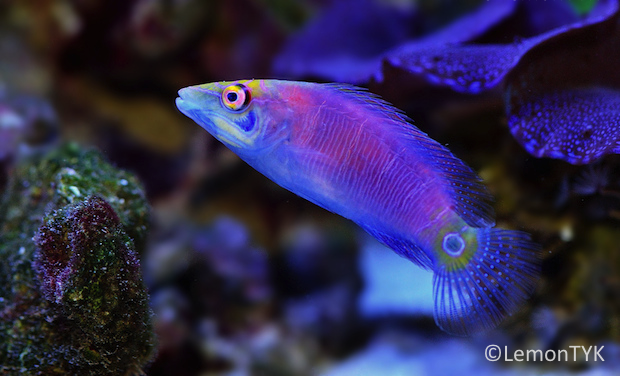It’s been awhile since our last Awesome Fish Spotlight, and today we’re featuring the mystical Mystery Wrasse. To be honest I have no idea why this fish is called the Mystery Wrasse. There’s a certain pensive sinister look to this fish. Perhaps it stems from its yellow head gear adorned with psychic pink stripes that possess a certain “seen-only-in-comics-purple-lightning” quality about it. Maybe it’s that bright yellow eye, or that hypnotising eye-spot on its caudal peduncle.

The Mystery Wrasse is one of seven members in the genus Pseudocheilinus, which feature small to medium sized secretive fish that keep close to the sanctity of the reef. Of this genus, P. hexataenia (The Six-lined Wrasse) is the most commonly offered species. Pseudocheilinus ocellatus got its name from its caudal eye spot which is a defining diagnostic for this species.
It also possesses five vertical white bands of varying intensity. Some individuals have highly contrasting white stripes, while others appear to have none. The age as well as geographic distribution of the species plays a part in its striping and overall appearance.

In the aquarium, Pseudocheilinus ocellatus may become belligerent and aggressive towards congeners. In the wild however, they are secretive and shy, preferring to stick close to rock work and coral. Out of the seven species, only the highly beautiful Pseudocheilinus citrinus is currently unobtainable, being found mostly in the French Polynesian chain of islands. The other species are generally wide ranging and aquarium staples.

P. ocellatus is widespread in the Western and Central Pacific, including Hawaii where it is rare. A large majority of the aquarium imports come from the Marshall Islands, and sometimes Vanuatu. The species is also found and exported, although rarely, from the Philippines. The above two images are of a Philippine caught individual.

Mystery Wrasse is highly variable in its appearance: Some individuals have bone-white stripes, while others have yellowish ones. Some may not even have any stripes. Generally, juveniles have a stronger propensity to display their striping, and it may or may not fade away as the fish transits into adult hood. Even the base colour of the fish is highly variable, ranging from indigo, to pink, and sometimes even with a hint of fuchsia. Of all the different colour variations, none is more strikingly different than the Tahitian specimens.

The Tahitian version of the Mystery Wrasse has a luscious slaty golden sheen superimposed on its pink body. We’ve not seen this in any other specimens from any other location. Isn’t this hobby refreshing? Just when you thought you’ve seen it all, seen every Mystery Wrasse there is to see, and then boom – A yellow one. How mysterious indeed. And if that doesn’t get to you, then that hypnotising illuminati eye-spot on its tail will.



